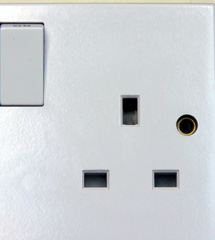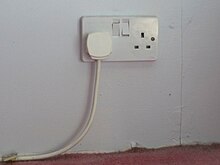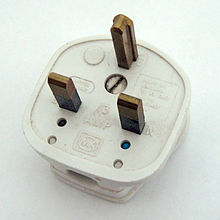Connector BS 1363
In the British connector , type G , and BS 1363 , "British 3-pin" or "Commonwealth plug", is a from the UK derived electrical connector system, wherein the electric power supply of households and generally in the low-voltage network application finds. Its use is recommended in the UK.
distribution
The following countries use the British connector exclusively as a standard connector system or partially with other systems:
See: Country overview of plug types, line voltages and frequencies
history
The structure and specification of BS 1363 take into account a specialty of house cabling that is generally only found in the United Kingdom and various former British colonies. The cabling consists of one or more cable rings per floor or per apartment, also known as a ring circuit . For each ring, a power cable is led from the fuse box from socket to socket through the apartment and from the last socket back to the fuse box. This feedback enables higher connection values with smaller cable cross-sections (a socket receives power from both directions of the ring). This can save copper in total. Whereas in the past only one ring per floor was common, it was later switched to, for example, one ring per apartment and then to several rings per apartment, e.g. an additional ring for the kitchen. Stub lines may be routed to individual sockets from a ring, but this is considered unclean. The star-shaped cabling that is common in other countries, such as Germany, is only slowly gaining acceptance.
BS 1363 was introduced in 1947; up to this point BS 546 (Type D) was standard. There are versions for 2, 5, 10 and more amperes , with 5 A being common in households. Accordingly, the circuit also had 5 A hedged are. Since this was too little power (240 V × 5 A = 1200 W) in the ring, it was decided to adopt new cabling regulations. The aim was to protect a ring with 16 A, 20 A or even 32 A, because one ring should be able to supply one or two electric radiators of 3000 W each (corresponds to around 12.5 A per radiator) and a number of smaller consumers. Since the current of 32 A from a single socket is too high for a normal device connection cable and strong, unwieldy device connection cables should be avoided, fuses had to be integrated into either sockets or plugs. The plugs were equipped with fuses of either 3 A, 5 A or 13 A. To prevent the old, unsecured BS-546 plugs from being used in a 32 A circuit, a new, incompatible socket standard was developed. BS 1363 was introduced in the UK in 1965 and quickly caught on there. The situation was similar in the other countries that use this standard. South Africa still uses a connector standard compatible with BS 546 to this day . The old plug-in system can still be found in the countries concerned in old installations from the period before 1965 and in special installations (such as in theaters).
standard
The British connector is defined in the British standard BS 1363. The standard requires that this connector is always three-pole and has a fuse. The contact pins are rectangular. Outer conductors and neutral conductors measure 4 × 6 × 18 mm; 9 mm of it is isolated. They have a distance of 22 mm. The protective contact is in the middle, above the two conductors at a distance of 22 mm. At 4 × 8 × 23 mm, it is longer than the live contact pins ( leading ) and without insulation. The live contact pins are polarized due to the rotational asymmetry (the outer conductor is always on the right-hand side of the socket or plug in the plug-in direction). The plug was widened at the point of the contact pins to make it more difficult to touch the contacts that were not isolated from the start ( finger-safe ). There is also a recessed grip to make it easier to pull the rather stiff plug out of the socket. Furthermore, the standard includes a child safety device that closes the contact holes from the inside. It is released by inserting the protective contact. Plugs for protection class II devices ( protective insulation ) only have a plastic pin instead of the protective contact.
- Connector cabling
- The BS 1363 standard also includes connecting the plug. It defines that the outer conductor in the open plug is always on the right when looking at the connections of the contact pins; the wires should be connected in such a way that when there is a tensile load, first the outer conductor, then the neutral conductor and finally the protective conductor is disconnected.
- tension
- Although connector systems can in principle be operated with different voltages, there are still some implicit standards. The British connector is specified for a maximum of 250 V and usually operated with 230 or 240 V at 50 Hz.
Similar norm
Similar to the British standard BS 1363 is the Irish standard of the NSAI I.S. 401 Safety Requirements for Rewireable 13A Fused Plugs for Normal and Rough Use Having Insulating Sleeves on Line and Neutral Pins .
safety
BS 1363 has the following security features:
- polarized / reverse polarity protected
- Leading protective contact
- Parental controls
- isolated contacts / finger-safe
- Fuse in the plug (3/5 / 13A)
advantages
- flexibility
- The cabling of the BS-1363 sockets is a typical loop system:
- Several fuse circuits and high currents are available exactly where several devices are currently required, as each plug has its own fuse.
- Availability
- As a result of a defective electrical device contacting the body , not a single socket is de-energized, only the defective device itself. The built-in fuse inside the plug switches off safely in the event of a short circuit or overcurrent. This overcurrent protection device in the plug works selectively, so only the part of the system that is directly affected in the event of a fault is switched off. This means that only the connected consumer is affected; other parts of the system in the electrical distributor ( sub-distributor ) continue to function independently.
- Economical cabling
- Comparable availability can only be achieved with star cabling if each socket is consistently supplied with a separate fuse circuit. Compared to this, the cabling effort is much lower, even if larger cable cross-sections have to be laid.
- Due to the ring topology, in which each socket is supplied from both sides, the otherwise necessary cable cross-section is reduced again.
disadvantage
- Possible circuit overload with an open ring
- The ring topology, in which each socket is supplied from both sides, enables the cable cross-section to be reduced. If use is made of the reduction, the ring must actually be closed in order to avoid line overload. The disadvantage is that a defective open ring will normally go unnoticed in practical operation.
- Operation with wrong plugs
- While BS 1363 is probably the safest household plug-in system and has become widely used, some of its safety features can lead to unsafe situations if used incorrectly. The Euro plug can also be found in all distribution states . Devices with a Schuko plug are often found in countries that are less strict about imports . Although both have round contacts, bypassing the (child) safety interlock (located in the grounding inlet) they can be forced into the square holes. With the Schuko plug, the force required for this can lead to the socket breaking. Apart from the missing protective conductor connection to the Schuko plug, there is a risk of overheating with all third-party plugs; on the one hand, because the socket contacts are not suitable for holding round pins, on the other hand, because the socket can be protected with up to 32 A , for which the cables of the third-party plug are by no means designed.
- costs
- Switches, fuses, child safety devices and, last but not least, the necessary insulation of the phase and neutral contact pins lead to high production costs for socket and plug. In particular, the rectangular cross-sections of the plug contacts are comparatively expensive to manufacture, since they usually have to be produced by milling. The use of solid brass for the wide contact pins also requires a large amount of material. Overall, the system is mechanically much more voluminous, robust, unwieldy and heavier than would be necessary today thanks to modern plastic injection molding technology for sufficiently good mechanical strength. Cost pressure in the production therefore makes cheap designs attractive for device manufacturers, in which, for example, the contact pins are composed of sheet metal strips. However, such variants do not make sense for the currents that can be transmitted.
- Surefootedness
- Dropped BS 1363 plugs are usually with the angular contacts facing up.
variants
Some manufacturers have developed variants of BS 1363. They are used where the insertion of conventional plugs is either not wanted or recommended. Examples are sockets in public buildings that are necessary for internal use, but which are not intended for use by unauthorized persons.
The most common is a variant of MK electric with a T-shaped protective contact.
Walsall manufactures plugs and sockets with contact pins rotated by 90 ° compared to the standard version. These are used for networks with 110 V operating voltage ( London Underground ) or with an uninterruptible power supply for special applications.
See also
Sources and individual references
- ^ Statutory Instrument 1994 No. 1768 , The Plugs and Sockets (Safety) Regulations. (English)
- ^ Uncommon British plugs and sockets . Digital Museum of Plugs and Sockets. Retrieved February 23, 2016.
-
British Standards BS 1363: 13 A plugs, socket-outlets, adapters and connection units.
- Part 1: Specification for rewirable and non-rewirable 13 A fused plugs. BS 1363-1: 1995.
- Part 2: Specification for 13 A switched and unswitched socket-outlets. BS 1363-2: 1995.
- Part 3: Specification for adapters. BS 1363-3: 1989.
- Part 4: Specification for 13 A fused connection units switched and unswitched. BS 1363-4: 1995.



